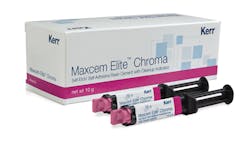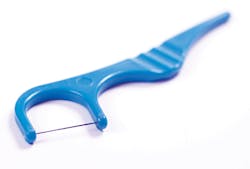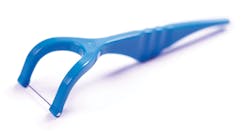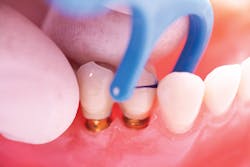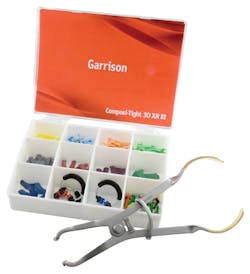Pearls for Your Practice
Joshua Austin, DDS, FAGD, reviews Kerr's Maxcem Elite Chroma resin cement, Directa Dental's SpotIt contact finder, and Garrison Dental Solutions's Composi-Tight 3D XR sectional matrix system.
Maxcem Elite Chroma resin cement by Kerr
Whenever I lecture on restorative dentistry, the segment of the program about cements always brings the most questions and concerns from other dentists. With the broad spectrum of materials available to us, it is no wonder that there is mass confusion about what to use, when to use it, and what to pair it with. Finding a go-to cement is an important part of restorative dentistry. Maxcem Elite Chroma can be your go-to resin cement because it has a feature that sets it apart from the rest.
Maxcem Elite Chroma is a self-etch, self-adhesive, one-step resin cement. It is versatile and compatible with pretty much any indirect restoration your lab could make for you, including ceramic, zirconia, resin, and metal. The original Maxcem Elite resin cement has been around for a couple of years and has performed well, but Kerr has upped its game by adding a unique feature that sets the Chroma version apart. Maxcem Elite Chroma has a color-changing cleanup indicator built in! At first, it's almost a fuchsia color. As it sets, that color fades away, leaving it white. As the color fades, you have a visual cue to indicate when it's the right time to clean up the cement. This handy feature helps you make sure that you don't wait too long to clean up, which can make life difficult. It also helps you avoid cleaning up too soon, which can cause potential contamination and lead to future problems.
Maxcem Elite Chroma has three potential curing options: dual cure, tack cure, and immediate cure. Dual cure is my preferred curing method for this resin cement because it helps me take advantage of the color-changing indicator, but if you're accustomed to tack curing, you can certainly continue doing that with this product. In my office, my assistant gets the restoration ready to cement and takes a bitewing radiograph to ensure full seating. Then I come in and inspect the restoration. If all is well, I clean the surface of the ceramic, if indicated. My assistant loads the restoration with Maxcem Elite Chroma, and I insert it. The patient is instructed to bite firmly on a cotton roll. I leave the room, and my assistant is in charge of cleanup. With Maxcem Elite Chroma, she can easily tell when it's the optimal time for cleanup due to the color-changing indicator-it's approximately two minutes. At that point, cleanup is quick and easy, and the crown is stable and secure.
RELATED | Dr. Austin demos Maxcem Elite Chroma resin cement from Kerr (VIDEO)
It is very nice having a product like Maxcem Elite Chroma around the office that can handle pretty much any cementation that I might need to do. I would definitely recommend taking a look at the instructions before using the product to verify your precementation protocol, based on the material you're using. It's always good to review how different cements and materials should be handled together prior to cementation. Hard-hit single into left field for Kerr!
SpotIt contact finder by Directa Dental
Inserting a new crown, bridge, or veneer can be one of the most satisfying procedures in dentistry or one of the most frustrating. Nothing is better than having a fixed restoration drop in with no adjustment, function well, and look good. The inverse is true when an indirect restoration gives us trouble. The frustration can be maddening. When an indirect restoration isn't seating, the most common issue is interference with the interproximal contact, which is the area most likely to require adjustment on laboratory-fabricated restorations. SpotIt, a contact finder from Directa Dental, can help us identify interferences quickly and efficiently, so we can eliminate them precisely and cement the restoration.
Accidentally overtrimming or polishing away an interproximal contact on a provisional is easy to do. I think many provisional restorations leave our offices with slightly open interproximal contacts. When this happens, teeth can move ever so slightly, requiring us to adjust tight interproximal contacts two weeks later during the insert appointment when, once again, there is a risk of overadjustment. If we accidentally overadjust a final restoration, we might need to send it back to the lab for a new contact to be added, or we might leave a light or open interproximal contact in the patient's mouth-and neither of these scenarios is a great practice builder.
The SpotIt contact finder can help make this process much easier. The SpotIt contact finder looks similar to a floss pick with color-disclosed floss. Two handle options-one straight and one angled-are available to allow for usage on both anterior and posterior restorations. The color-disclosed floss transfers its blue pigment to the contact point on the restoration. If the contact is tight, you know exactly where, which makes adjustments much more precise and helps ensure that the contact isn't adjusted too much. SpotIt is much neater and easier to use than other options, such as articulation aerosol, and an assistant can use it easily when working alone.
In my office, we use the SpotIt contact finder in approximately one out of every 10 cases. It's likely that you won't need it on every case either. If you do, there might be an issue with your provisionals, impressions, or lab! SpotIt is great to have around for the cases that are tough, such as when a provisional has been off for a couple of days or when a contact's shape makes it difficult to tell where the restoration is being held up. The cost is minimal, and I would highly recommend having some on hand. The SpotIt contact finder can be ordered directly from Directa Dental, which also sells some other really great products that you can check out on its website. Solid line-drive single up the middle for Directa Dental!
Composi-Tight 3D XR sectional matrix system by Garrison Dental Solutions
I've discussed Class II posterior interproximal restorations countless times in "Pearls for Your Practice." They remain, based on the traditionally lower reimbursement rates, one of the biggest headache procedures I do. They can be complicated and difficult, yet there generally isn't a way to get a higher reimbursement rate. One of the biggest challenges with Class II restorations is getting a tight interproximal contact while maintaining the curvy natural embrasures-which is a difficult task with resin composite. With amalgam, interproximal contact is easy to achieve because it can be packed into the contact area, and no polymerization shrinkage occurs. Due to the way amalgam sets and how easy it is to carve, maintaining curvy embrasures is usually a simple task. With resin composite, on the other hand, we have to fight shrinkage, and the majority of our "carving" must be done with a bur. It can be difficult to achieve with composite what's easily done with amalgam, but we soldier on . . . searching for products to help us along the way. The Garrison Dental Solutions Composi-Tight 3D XR sectional matrix system is a magnificent choice to simplify and expedite our Class II posterior composites.
Most sectional matrix systems have the same basic components: matrices, wedges, and rings. This sectional matrix system is no exception-however, it comes with so much more. It includes an assortment of FenderWedges, 3D XR Slick bands, 3D Fusion Wedges, and three rings.
The wedges in the kit probably deserve their own "Pearl." The new 3D Fusion Wedges are phenomenal. They are adaptive and help close the gap in the gingival third of the matrix band. The FenderWedges are also a cool element of the kit and are very useful. Basically, a FenderWedge is a plastic wedge that has a small, thin piece of metal sticking out of the top to protect the adjacent tooth from iatrogenic damage. (As slick as I like to pretend I am, sometimes I nick the adjacent tooth in tough situations.) A FenderWedge gives us all of the advantages of pre-wedging while offering protection.
RELATED | Garrison Dental Solutions introduces Composi-Tight 3D Fusion Ultra Adaptive Wedge
The 3D XR Slick bands are the matrices of the kit. They are thin (.0016") and coated with a thin barrier that prevents them from bonding to the composite. The bands are available in five sizes to help in many different situations.
The 3D XR kit comes with three rings: two of the Composi-Tight 3D rings and one Composi-Tight Soft-Face 3D XR ring. Both rings are great, but the Soft-Face 3D-XR ring is my favorite. It has a tenacious grip to help prevent the ring from springing off of the tooth, which can sometimes happen with other rings. The Soft-Face part adapts the matrix to the tooth around the line angles, which yields better embrasures so less finishing is required after placement.
After using the Garrison Composi-Tight 3D XR kit for the past few weeks, I have spent less time finishing Class II composites and have been happier with my results. Restorations have gone smoothly and quickly with minimal stress and trouble. If you routinely place posterior composites, I think a sectional matrix system is an absolute must-have. I consider the Garrison Composi-Tight 3D XR system to be one of the very best on the market-if not the best. Give it a shot for yourself. Line-drive triple to deep center for Garrison!
